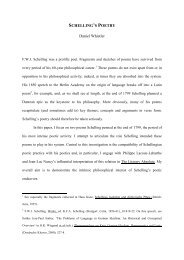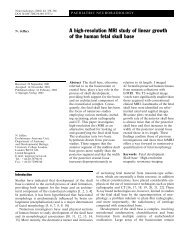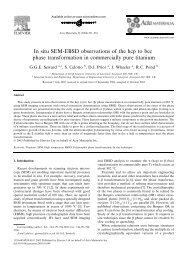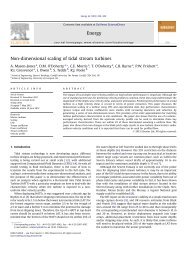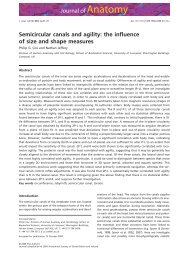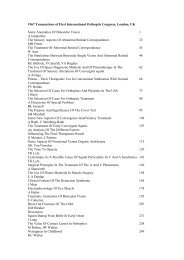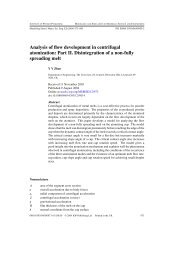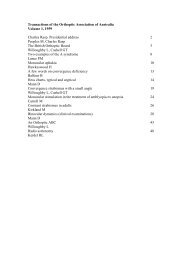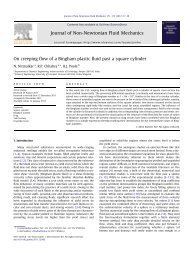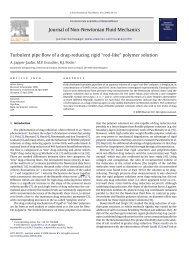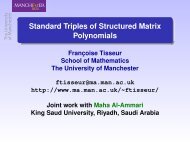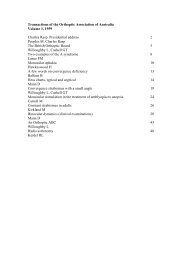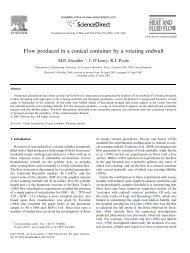Beyond the Pre-Pottery Neolithic B interaction sphere - University of ...
Beyond the Pre-Pottery Neolithic B interaction sphere - University of ...
Beyond the Pre-Pottery Neolithic B interaction sphere - University of ...
You also want an ePaper? Increase the reach of your titles
YUMPU automatically turns print PDFs into web optimized ePapers that Google loves.
114 J World <strong>Pre</strong>hist (2006) 20:87–126<br />
Çatalhöyük<br />
As noted above, <strong>the</strong> operation <strong>of</strong> regional <strong>interaction</strong> <strong>sphere</strong>s as vehicles <strong>of</strong> substantial<br />
contacts between communities can be amply demonstrated for certain cases <strong>of</strong> Early<br />
<strong>Neolithic</strong> colonizations. Their specific local contexts, however, differ: at Çatalhöyük such a<br />
process was probably necessary for achieving group cohesion and negotiating social and<br />
territorial legitimation in an area that was already inhabited (Asouti, 2005; Baird, 2006).<br />
For example, <strong>the</strong> lithic assemblages obtained from <strong>the</strong> earliest excavated levels at<br />
Çatalhöyük have shown <strong>the</strong> transient presence <strong>of</strong> multiple chaînes opératoires known from<br />
central Anatolian assemblages at Pınarbas¸ı A, Canhasan III, Suberde (Konya Plain),<br />
As¸ıklı, Musular (Cappadocia), as well as traditions found region-wide including PPNB<br />
territories in sou<strong>the</strong>ast Anatolia and <strong>the</strong> Levant (Carter et al., 2005). It would appear<br />
<strong>the</strong>refore that <strong>the</strong> early community <strong>of</strong> Çatalhöyük comprised both local (Konya plain) and<br />
‘‘non-local’’ elements (west Cappadocia and, conceivably, sou<strong>the</strong>ast Anatolia and <strong>the</strong><br />
Levant too). However, this early diversity wanes through time and, by <strong>the</strong> end <strong>of</strong> <strong>the</strong> eighth<br />
millennium BC, is replaced by much more homogeneous assemblages, thus indicating a<br />
process <strong>of</strong> localization (ibid.). The rapid process <strong>of</strong> settlement nucleation that eventually<br />
resulted in Çatalhöyük becoming something akin to a ‘‘mega-site’’ with no habitation sites<br />
(affiliated or independent) co-existing with it in <strong>the</strong> Konya plain (Baird, 2002) is perhaps<br />
<strong>the</strong> best testimony for <strong>the</strong> successful creation <strong>of</strong> a shared group identity among <strong>the</strong><br />
<strong>Neolithic</strong> inhabitants <strong>of</strong> <strong>the</strong> western Konya plain. The persistent presence <strong>of</strong> a symbolic<br />
and cultural vocabulary rich in locally derived as well as sou<strong>the</strong>ast Anatolian and<br />
Levantine elements, mainly associated with burial/ancestor rituals and feasting ceremonies,<br />
might have been one key element in <strong>the</strong> creation <strong>of</strong> a shared group identity (Asouti,<br />
2005; Baird, 2006). This is fur<strong>the</strong>r indicated by <strong>the</strong> recurrence <strong>of</strong> its material signifiers<br />
(bucrania, plaster decoration, wall-paintings, etc.) inside inhabited spaces and by <strong>the</strong><br />
concurrent absence <strong>of</strong> communal mortuary places and/or public structures (such as <strong>the</strong><br />
ritual/public spaces found in sou<strong>the</strong>ast Anatolia and <strong>the</strong> Levant; Rollefson, 2000; Kuijt &<br />
Goring-Morris, 2002; Verhoeven, 2002a). This suggests <strong>the</strong> fur<strong>the</strong>r symbolic empowerment<br />
<strong>of</strong> <strong>the</strong> household at <strong>the</strong> expense <strong>of</strong> supra-community bodies comprising ritual<br />
specialists and/or civic leaders (Asouti, 2005).<br />
This pattern does not exclude <strong>of</strong> course <strong>the</strong> presence <strong>of</strong> groups or even individual ritual<br />
specialists and authority structures, based on <strong>the</strong>ir membership in age groups and/or<br />
individual qualities (such. as elders, practitioners <strong>of</strong> magic, healers, shamans, etc.). Such<br />
figures might have mediated in <strong>the</strong> event <strong>of</strong> intra-communal disputes and directed corporate<br />
decision-making. Evans-Pritchard (1987, especially pp. 172–181) discussed <strong>of</strong> <strong>the</strong><br />
role <strong>of</strong> such institutions, which are characterized by <strong>the</strong> intentional absence <strong>of</strong> ascribed<br />
and/or hereditary political leadership and thus <strong>of</strong> coercive political influence, among <strong>the</strong><br />
segmentary societies <strong>of</strong> <strong>the</strong> Nuer in Sudan. The most recent excavations at Çatalhöyük<br />
have provided some strong indications that comparable role differentiations were part <strong>of</strong><br />
<strong>the</strong> life <strong>of</strong> <strong>the</strong> community. For example, a find with no parallel elsewhere in <strong>the</strong> region is<br />
<strong>the</strong> clay figurine presented in Fig. 11, which is strongly suggestive <strong>of</strong> magical practices. It<br />
could be plausibly argued that this figurine is likely to have been used as a talisman in <strong>the</strong><br />
context <strong>of</strong> some sort <strong>of</strong> magic performance to protect a woman from <strong>the</strong> dangers <strong>of</strong> childbirth.<br />
It remains impossible, however, to suggest that <strong>the</strong> use or even manufacture <strong>of</strong><br />
such items was restricted to particular segments <strong>of</strong> <strong>the</strong> local society (see Meskell &<br />
Nakamura, 2005).<br />
The occurrence <strong>of</strong> obsidian points with clear traces <strong>of</strong> impact damage, perhaps as<br />
hunting ‘‘trophies’’ symbolizing personal achievement (Carter et al., 2005) could also<br />
123



